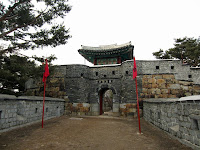Osan Military Base, also known as K-55, is located on the northern part of Songtan, Pyeongtaek City. Contrary to its location, the name Osan was chosen since it is hard to pronounce and remember the names of nearby areas.
Across the base is the popular Shopping road or Arcade Street. This is one of the places in Pyeongtaek-si where you can find people from different parts of the world all at once. Many who just want to relax come here especially during weekends.
If you're planning to go hardcore bar-hopping on a Saturday night, Arcade Street in front of Osan Military Base is a good choice. The entire strip, including the small alleys, is a chain of bars and clubs. Some even offer live music. But Blue Opera caught my attention with their big and maybe we can call it artistic (though scary) facade.
If you're not much of a drinker and just plain love shopping, you'll enjoy every nook of the area with both Korean and U.S. boutiques. Many stores have American brands, mostly sporty goods, that are hard to find in Korean Malls. Not all would offer a good deal though, so try to search in the internet first for prices if you have things in mind that you plan to buy and want to compare. Cosmetics shops offer a better deal in Pyeongtaek-ro area than in K-55 so you may also want to check that out. It's just four stations away from Songtan, anyway.
High quality Korean goods from collectible dolls in Hanbok to elegant bed covers are also here. Children's toys, pillows, pajamas and anything you need in your apartment is here.
Being away from home makes anyone miss their local food and coming to K-55 may give you a chance to enjoy something native to your palate. Food that you've been craving since you stepped foot on South Korea may be here! If you're sick of sundaekuk and kimchi or grabbing burger from a Korean burger chain or the usual ice pop from the supermarket, McDonald's and Baskin' Robbins are here. I even found a Filipino restaurant which has halo-halo and leche flan in their menu! Too bad it's closed when we went there. Before hitting McDonald's, I just had to beg for some streetfood. It's been a year since my boyfriend, now my husband, bought me something from the street. The spicy chicken on stick perked me up.
A few turns around alleys will take you to a market where you can find the usual goods you need in your kitchen. There are also small houses for rent at a low cost nearby, where a lot of foreigners reside.
We were advised by an ahjumma to get a cab to and fro K-55 from Songtan Station but, again, we preferred to walk and enjoy the conversation and the unfamiliar roads. It's approximately a 15-minute walk if you're up for it like we do.
Here's how to get to Arcade Street :
- From Songtan Station Line 1, walk to your right after you exit the station. Walk down the stairs from the bridge and turn right on the next street. This is the Tanhyeon 1-ro. You'll see a parking lot to your right.
- Walk straight ahead until you see a flyover or an elevated road perpendicular to Tanhyeon 1-ro.
- Cross the street and walk under the elevated road. If you're familiar with Quiapo, Manila, it's as if you're walking under the Quezon Bridge with all the fruit and streetfood vendors minus the native handicrafts.
- Keep walking until the end of the road and turn right. You should be in Sinjang-ro now.
- Follow the slight curve of the road to the left and you'll see the gate of Osan Military Base. If you see it from this angle (check the first photo), you're probably standing at the corner of Sinjang and Arcade Streets.
 |
| Osan Military Base |
 |
| Arcade Street/ Shopping Road |
 |
| Yummy Korean street food |
 |
| McDonald's Angus Burger |

































